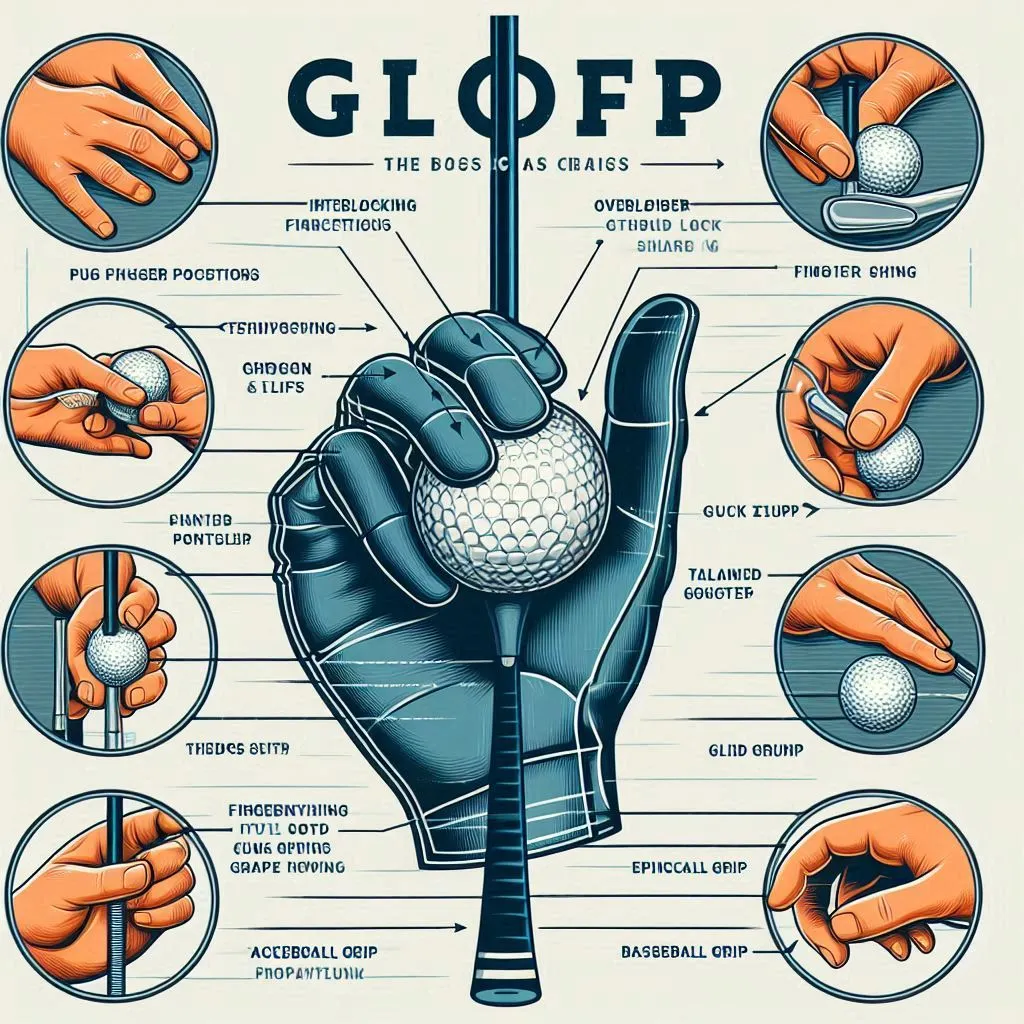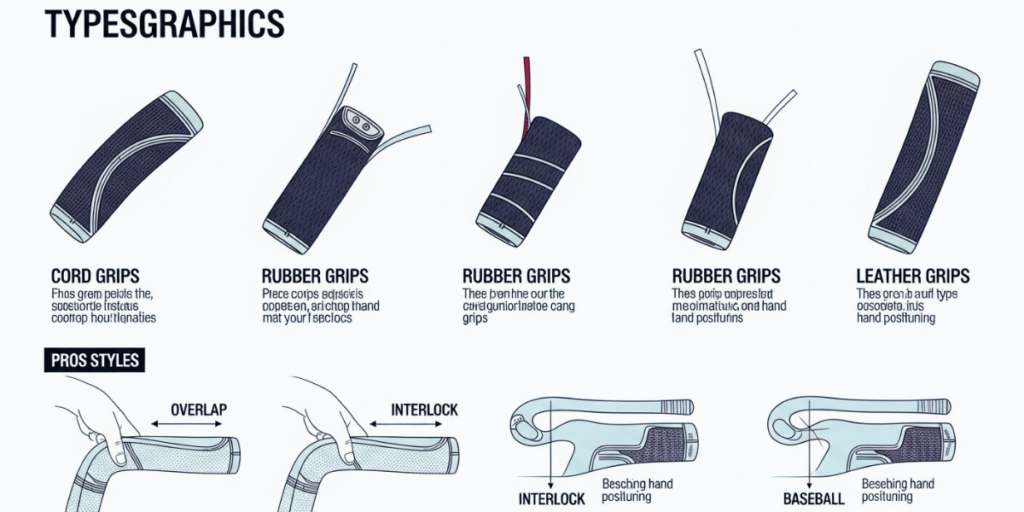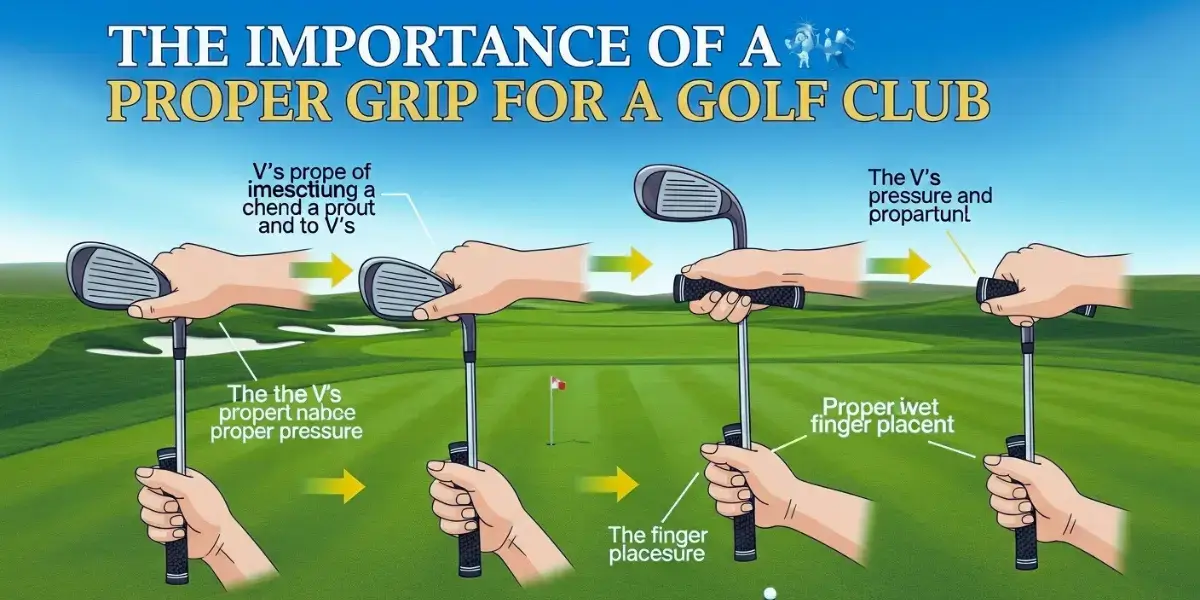Your hands are the only part of your body that touch the proper grip for a golf club. This makes your grip really important for good golf. A lot of people who are just starting to play golf don’t think much about how they hold the club. But here’s the thing – your grip affects every single shot you take. When you hold the club the right way, you’ll hit better shots that go where you want them to go.
Your grip is like the steering wheel of a car. If you can’t steer properly, you won’t get to where you want to go. Same thing happens in golf. If you don’t hold the club right, your ball will go all over the place, even if you think you’re swinging well. A good grip makes you feel secure and confident. It helps you swing with more strength and control. Getting your grip right is the very first thing you should learn if you want to play better golf.
Understanding the Basics of a Golf Club Grip

A correct grip on a golf club is essential for consistent ball striking and distance control. It is important to grip the club with both hands, but the level of pressure applied should be light to avoid tension in the hands and arms. The lead hand should be positioned on the club first, with the heel pad on the top of the grip and the thumb slightly to the right of center. Begin holding the golf club by first grasping the top of the handle with your right hand.
Next, position your left hand alongside the grip, making sure that your fingers are pointed downwards towards the ground. The grip should extend from the center joint of your forefinger to the bottom of your pinky finger.
Step-by-Step Guide to Holding a Golf Club
Here we help you to guide how to hold a golf club grip. There are three types of golf grips. Before you try different ways of holding a golf club, it’s important to get to know your club first. These step-by-step instructions will help you to make a strong foundations for your grip.
Note: these are for right-handed golfers
Here are some simpler instructions for how to hold a golf club:
- Hold the club waist-high in front of you, making it horizontal to the ground and square the club face.
- Start by grabbing the club with your left hand first, stretching out your fingers and aligning the handle with your left palm in a straight line diagonally across your fingers.
- Close your hand around the club, with the heel of your palm resting along the top edge of the handle.
- Rotate your hand to the right until you can see two knuckles on your left hand when you look down. This will give you a neutral grip.
- Place the heel of your right hand on top of your left thumb, covering your left hand. Close your hand so your thumb and forefinger create a ‘V’ that points to the middle of your chest.
Choosing the Right Grip Size
Because we seeing about Right handed griping then, we saw the right grip size is an important factor in ensuring you have a comfortable and effective grip on your golf club.
Here are some simple things to keep in mind when selecting the right grip size:
Hand Size:
The size of your hands will determine the grip size you need. If you have larger hands, you will need a larger grip size, while smaller hands require smaller grip sizes.
Grip Thickness:
The thickness of the grip will also affect how it feels in your hand. A thicker grip will provide more stability, but it may also make it harder to release the club at impact. Thinner grips provide more feel, but may not be as stable.
Club Type:
Different types of clubs may require different grip sizes. For example, woods and irons may require different grip sizes based on the length and weight of the club.
Comfort:
Finally, the grip size you choose should feel comfortable in your hands. If you find that your hands are slipping or you have to grip the club too tightly, it may be a sign that you need a different grip size.
These factors and experimenting with different grip sizes, you can the right grip size for you and improve your overall golf game.
The Role of the Fingers
The fingers play an important role in holding and controlling the golf club during the swing. They need to be positioned correctly to ensure a secure grip and allow for proper wrist hinge and release, which can greatly affect the accuracy and power of the shot.
Here some point of The Role of the Fingers in golf:
What do the Fingers Do in a Grip?
The fingers provide stability and control in the golf swing. The way you position your fingers can affect your grip strength and club control.
How do the Fingers Affect the Swing?
The position of your fingers can affect the direction and power of your shots. Using the fingers properly can help you create more clubhead speed and generate more distance.
Tips for Finding the Right Finger Position for You
- Experiment with different finger positions to find what works best for you.
- Seek guidance from a golf instructor or use training aids to improve your finger positioning.
- Practice regularly to develop proper finger technique and improve your golf game.
The Pinky Finger and Its Role in the Grip
Now, let’s chat about your smallest finger: your pinky! You might not think it does much, but it’s super important when you’re holding a golf club.
Imagine trying to pick up something heavy. You use all your fingers to get a good hold, right? It’s the same with your golf club. Your pinky finger, especially with your ring finger, helps you get a strong “feel” for the club. It makes the club feel like it’s really part of your arm, not just something you’re holding loosely.
Here’s why your pinky is a big deal:
- It keeps things steady: If your pinky isn’t doing its job, your grip can feel a bit shaky. The pinky helps “lock” the club into your hand, making it much steadier when you swing.
- It helps you steer: A steady grip means you have more control over the club. This helps you point the club face the right way and hit the ball where you want it to go.
- It stops slips: When you swing hard, there’s a lot of power. Your pinky, along with your other fingers, helps make sure the club doesn’t slip out of your hand.
So, even though it’s tiny, your pinky has a lot of power when you’re holding a golf club. Making sure all your fingers, including your pinky, are in the right spot can really improve your golf game!
Types of Golf Grips
There are three main types of proper grip for golf club: the overlapping grip, the interlocking grip, and the ten-finger grip. Sure there is no one-size-fits-all grip when you learn how to hold a golf club, then it helps to you know the differences.

The Interlocking grip
The interlocking grip is a popular grip in golf that involves interlocking the pinky finger of your trailing hand with the index finger of your lead hand. This grip is favored by many golfers, including Tiger Woods and Jack Nicklaus, and is considered to provide more power and control over the club.
One of the main benefits of the interlocking grip is that it allows golfers with smaller hands or weaker grips to make more power and control over the club. This is because the grip enables them to maintain a stronger connection between their hands and the club, leading to a more stable and consistent swing.
Next, place the pinky finger of your trailing hand between the index and middle fingers of your lead hand. Interlock your fingers, making sure that both hands are securely connected to the club. It’s also important to seek guidance from a golf guider or experienced golfer to ensure that you are using the interlocking grip correctly and effectively.
The Overlapping grip
The overlapping or “vardon” grip is another popular grip used by many golfers. It is particularly popular among those with larger hands.
To use the overlapping grip, place your left hand on the club with your thumb pointing down the shaft. Then, take your right hand and place it on the club, with your right pinky finger resting on top of your left index finger.
The main advantage of the overlapping grip provides a strong connection between the hands, which can help provide greater control over the club.
The ten-finger grip
The ten-finger grip, also known as the “baseball grip,” is a type of grip commonly used bynewcomer golfers or those with weaker grips. As the name suggests, player put his each ten fingers on the club, just like you grip a baseball bat.
One of the main benefits of the ten-finger grip is that it provides more surface area to grip the club, which can help create more power and control. This can be especially helpful for golfers with smaller hands or weaker grips who may learn how to create enough power with other types of grips.
To use the ten-finger grip, place the club in your lead hand (left hand for right-handed golfers) with your fingers wrapped around the club.
Differences in Holding a Driver Vs a Putter
Are you a golf lover looking to perfect your game? Or are you new to the sport and excited to learn the basics? No matter where you stand, understanding the differences between holding a driver and a putter is a important of playing golf.
Holding a golf club may seem like a simple task, but it’s more than just picking up the club and swinging it. The way you hold the club can significantly impact your swing and ultimately determine the outcome of your shot.
We’ll explore the key differences between holding a driver and a putter, two of the most critical clubs in a golfer’s bag. From the length of the club to its weight and grip, we’ll break down everything you need to know to master your swing and take your golf game to the next level. So, let’s start in and explore the differences between holding a driver vs a putter!
Holding a Driver:
- Grip pressure: When holding a driver, you should use a lighter grip pressure than when holding a putter. This is because a lighter grip pressure can help you generate more clubhead speed and distance.
- Hand placement: When holding a driver, your top hand (the left hand for right-handed golfers) should be placed lower on the grip than when holding a putter. This helps you create a sweeping motion through the ball, rather than a downward strike.
- Stance: When hitting a driver, you should have a wider stance than when hitting a putter. This helps you maintain balance and generate more power in your swing.
Holding a Putter:
- Grip pressure: When holding a putter, you should use a firmer grip pressure than when holding a driver. This helps you maintain control and accuracy on shorter, delicate putts.
- Hand placement: When holding a putter, your hands should be placed evenly on the grip, with your top hand (again, left hand for right-handed golfers) slightly ahead of the ball. This helps you create a consistent putting stroke and avoid hitting the ball with the club’s heel or toe.
- Stance: When putting, you should have a narrow stance with your feet close together. This helps you maintain balance and control throughout your putting stroke.
FAQs
What is the correct way to grip a golf club?
Place your left hand on top with your thumb pointing down the shaft, then put your right hand below it. Connect your hands by either overlapping your right pinky over your left hand or interlocking your pinky with your left pointer finger.
What is the perfect golf grip?
There’s no single “perfect” grip, but a good grip should feel comfortable and secure while allowing both hands to work together. Your grip pressure should be firm but not tight – like holding a small bird that you don’t want to hurt or let fly away.
What is the best grip for putting in golf?
For putting, many golfers use a “reverse overlap” grip where you put your left pointer finger over your right fingers. This helps keep your wrists steady during the putting stroke for better control.
How to properly regrip a golf club?
Regripping involves removing the old grip, cleaning the shaft, applying grip tape and solvent, then sliding on the new grip. Most golfers have this done at a golf shop since it requires special tools and materials.
Final thoughts
In conclusion, having a proper grip for golf club is crucial for achieving both consistency and accuracy in your swing. Since the grip is the only point of contact between the player and the club, it’s vital to make sure you’re holding it correctly to ensure a solid swing. Begin by placing your lead hand on the club, positioning the heel pad on the top of the grip and your thumb slightly to the right of center.
Proper positioning of your fingers, palms, and thumbs is essential to maintain a square clubface throughout your swing. Selecting the right grip size is also critical to having a comfortable and effective grip. Additionally, your fingers play a crucial role in holding and controlling the golf club, including your pinky finger, which contributes to stability and control. By learning the basics of a proper grip for golf club and experimenting with different finger positions, you can enhance your golf game and achieve your desired outcomes.


